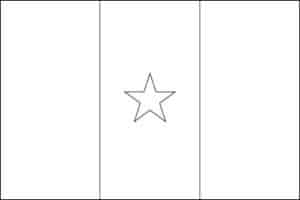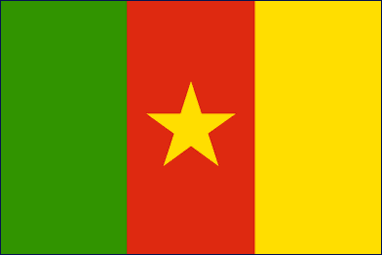
After Cameroon became a unitary state on May 20, 1975, the country’s national flag was formally approved. The flag has three vertical stripes: the left stripe is green, the centre stripe is red, and the right stripe is yellow.
A five-pointed yellow star with crimson accents is located in the center of the flag. The star is sometimes referred to as the “star of unity,” and its crimson backdrop symbolizes unity.
The pan-African spirit is embodied by the colours of the Cameroonian flag.
The colours yellow and green stand for joy and optimism, respectively.
Facts about the Cameroon flag |
| Country | Cameroon |
|---|---|
| Adopted | May 20, 1975 |
| Revision | 1957, 1961, 1975 |
| Design and Colors | A vertical tricolor of green, red and yellow, with a yellow star centered on the red band. |
| Size Ratio | 2:3 |
| Official Name: | Republic of Cameroon |
| Proportion: | 2:3 |
| Adopted on: | May 20, 1975 |
| Location: | West-central Africa is bordered by Nigeria, Chad, the Central African Republic, Equatorial Guinea, Gabon, and the Republic of the Congo |
| Capital City: | Yaounde |
| Major Cities: | Touboro, Fotokol, Dschang, Batouri, Moloundou |
| Area: | 183,568 square miles. |
| Population: | 19,100,000 |
| Currency: | Central African CFA franc (XAF) |
| Official Languages: | French, English |
| National Day | Cameroon National Day is celebrated on 20th May to mark the abolition of the federal government system and the formation of a unitary state |
| National symbol(s): | lion |
| National colors: | green, red, yellow |
| National anthem: | |
| Name: | “O Cameroun, Berceau de nos Ancetres” (O Cameroon, Cradle of Our Forefathers) |
| Lyrics/Music: | Rene Djam AFAME, Samuel Minkio BAMBA, Moise Nyatte NKO’O [French], Benard Nsokika FONLON [English]/Rene Djam AFAME |
Historical Background
The current design of the Cameroonian flag was officially adopted on May 20, 1975, following a national referendum that approved the change from a previous design. The flag’s design reflects the country’s diverse population and its vision for a united and prosperous nation.
Design and Colors
The Cameroonian flag features three vertical bands of equal width. From left to right, the colors are green, red, and yellow.
Symbolism of the Cameroonian Flag
Each element of the Cameroonian flag holds significant symbolism. The green color represents the lush vegetation and natural resources of the country. It also symbolizes hope, growth, and vitality. The red color symbolizes the courage and unity of the Cameroonian people in their struggle for independence. The yellow color represents the country’s prosperity, sunshine, and bright future.
Cameroonian National Day
Cameroonian National Day is celebrated on May 20th each year, commemorating the day in 1972 when Cameroon became a unitary state following the unification of East Cameroon and West Cameroon. This day is marked by various celebrations, parades, and flag-raising ceremonies, showcasing the importance of the Cameroonian flag as a symbol of unity and national identity.
FAQs
Q1: When was the current design of the Cameroonian flag adopted?
The current design of the Cameroonian flag was officially adopted on May 20, 1975.
Q2: What do the colors on the Cameroonian flag represent?
The green color represents the lush vegetation and natural resources of the country, symbolizing hope, growth, and vitality. The red color symbolizes the courage and unity of the Cameroonian people in their struggle for independence. The yellow color represents the country’s prosperity, sunshine, and bright future.
Q3: What is Cameroonian National Day?
Cameroonian National Day is celebrated on May 20th each year, commemorating the day in 1972 when Cameroon became a unitary state following the unification of East Cameroon and West Cameroon.
Q4: What is the significance of the unification of East Cameroon and West Cameroon in Cameroonian history? The unification of East Cameroon and West Cameroon on May 20, 1972, marked a significant milestone in Cameroonian history, as it brought together two distinct regions into a unitary state. This event has played a crucial role in shaping the country’s identity and national unity.

